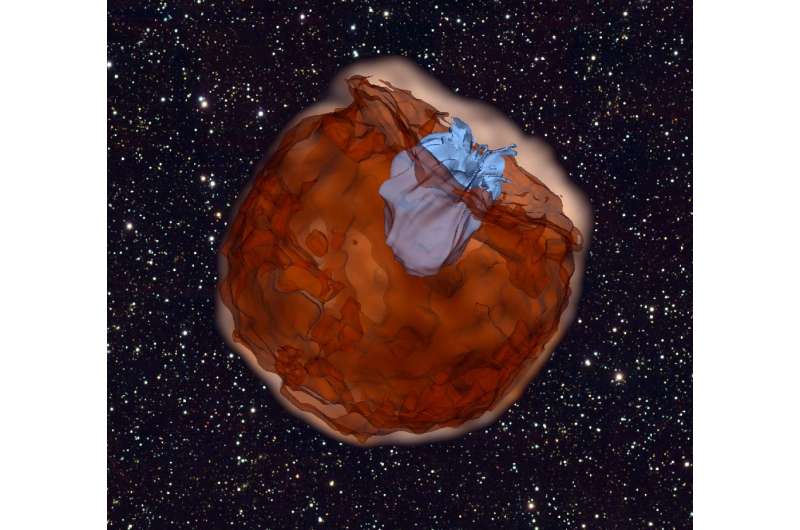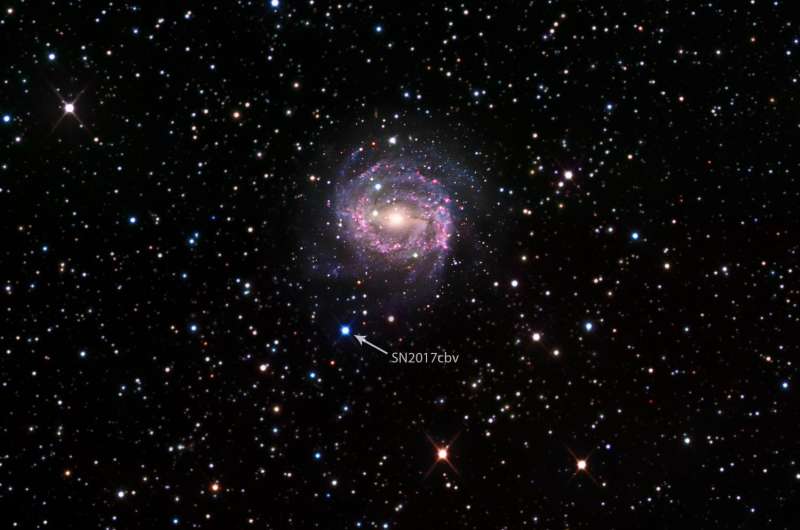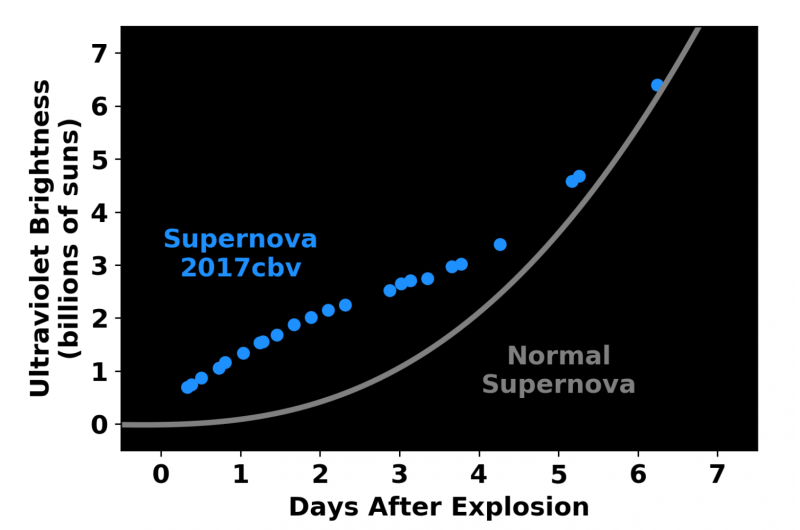Get them while they're young: Astronomers catch exploding supernova early (Update)

For the first time, astronomers have observed a cosmic event in great detail that they only had glimpses of before: a supernova and its explosive ejecta slamming into a nearby companion star. The discovery was made possible by a specialized survey taking advantage of recent advances in linking telescopes across the globe into a robotic network.
David Sand, an assistant professor at the University of Arizona, discovered the supernova on March 10, 2017, in the galaxy NGC 5643. At 55 million light-years, it was one of the closest supernovae discovered in recent years. Designated SN 2017cbv, it was found by the DLT40 survey, which stands for "Distance Less Than 40 Megaparsecs" or 120 million light-years. The survey uses the PROMPT telescope in Chile, which monitors roughly 500 galaxies nightly.
"This was one of the earliest catches ever—within a day, perhaps even hours, of its explosion," said Sand, who created the DLT40 survey together with Stefano Valenti, an assistant professor at the University of California, Davis. Both were previously postdoctoral researchers at Las Cumbres Observatory, or LCO.
Dead Stars Go Thermonuclear
Within minutes of discovery, Sand activated observations with LCO's global network of 18 robotic telescopes. They are spaced around the globe so that there is always one on the night side of the Earth, ready to conduct astronomical observations. This allowed the team to take immediate and near-continuous observations.
SN 2017cbv is a thermonuclear (Type Ia) supernova, the kind astronomers use to measure the acceleration of the expansion of the universe. Type Ia supernovae are known to be the explosions of white dwarfs, the dead cores of what used to be normal stars.
Across the cosmic abyss, a supernova tells of its existence by appearing like a star that wasn't there before. Its brightness peaks within a matter of days to weeks and then slowly fades over weeks or months.

"To turn into a Type Ia supernova, a white dwarf can't be by itself," explained Sand, the principal investigator of the DLT40 survey. "It has to have some kind of companion, and we are trying to figure out what that companion is."
The identity of this companion has been hotly debated for more than 50 years.
The prevailing theory over the last few years is that the supernovae happen when two white dwarfs spiral in toward each other and merge in a cataclysmic explosion. The other scenario involves a normal star that is not a white dwarf.
Key to the observations reported in this study is a small bump in the light curve emitted by SN 2017cbv within the first three to four days, a feature that would have been missed were it not for the almost instantaneous reaction times that are the hallmark of the DLT40 survey: a fleeting blue glow from the interaction at an unprecedented level of detail, revealing the surprising identity of the mysterious companion star.
"We think what happened here was likely scenario number two," Sand said. "The bump in the light curve could be caused by material from the exploding white dwarf as it slams into the companion star."
This study infers that the white dwarf was stealing matter from a much larger companion star, approximately 20 times the radius of the sun. This caused the white dwarf to explode, and the collision of the supernova with the companion star shocked the supernova material, heating it to a blue glow that was heavy in ultraviolet light. Such a shock could not have been produced if the companion were another white dwarf star, the study's authors say.
"We've been looking for this effect—a supernova crashing into its companion star—since it was predicted in 2010," said Griffin Hosseinzadeh, a doctoral student at the University of California, Santa Barbara, who led the study, which is soon to be published in The Astrophysical Journal Letters. "Hints have been seen before, but this time the evidence is overwhelming. The data are beautiful!

"With Las Cumbres Observatory's ability to monitor the supernova every few hours, we were able to see the full extent of the rise and fall of the blue glow for the first time," he added. "Conventional telescopes would have had only a data point or two and missed it."
Eighteen telescopes, spread over eight sites around the world, form the heart of the Las Cumbres Observatory. At any given moment, it is nighttime somewhere in the network, which ensures that a supernova can be observed without interruption.
Cosmology's '60-Watt Lightbulb'
Because of their uniform brightness, Type Ia supernovae are akin to a "standard 60-watt lightbulb for cosmology," and scientists use them as yard sticks to measure distances across the universe.
On average, only one supernova goes off over the course of a century in a galaxy like our Milky Way, according to Sand. Add to that their fleeting nature, and it becomes clear why a targeted observational campaign such as the DLT40 survey and an automated network of observatories such as the LCO are critical to their discovery and study. Funded by the National Science Foundation, The DLT40 survey started in October 2016 and is scheduled to continue over the next three years.
"The secret sauce to this are the connected telescopes of the Las Cumbres Observatory," Sand said, adding that the survey is not about quantity. "We rather focus on a precious few than hundreds of them."
It is likely that Type Ia supernovae come from both types of progenitor systems - two white dwarfs or one white dwarf and a "normal" interacting star - and the goal of these studies is to figure out which of the two processes is more common, Sand explained.
"Observing supernovae such as SN 2017cbv is an important step in this direction," he said. "If we get them really young, we can get a better idea of these processes, which hold implications for our understanding of the cosmos, including dark energy."
Journal information: Astrophysical Journal Letters
Provided by University of Arizona





















